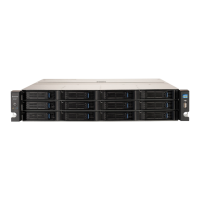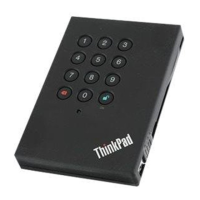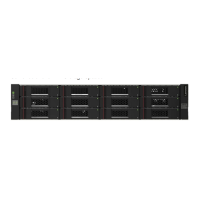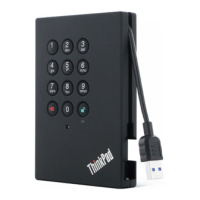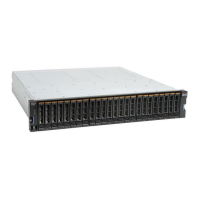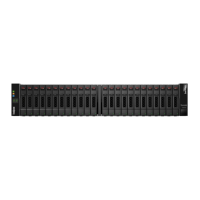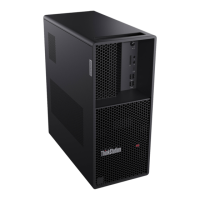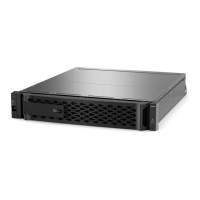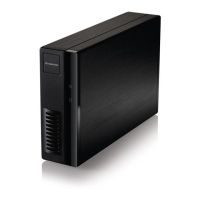
Do you have a question about the Lenovo EZ Media & Backup Center and is the answer not in the manual?
| USB Ports | 1 x USB 2.0 |
|---|---|
| Interface | USB 2.0 |
| RAID Levels | RAID 0, RAID 1, JBOD |
| Protocols | FTP |
| Remote Access | Yes |
| Storage Capacity | 1TB or 2TB |
| Compatibility | Windows |
Details on the initial setup process, including connecting the device and launching the setup utility.
Description of front and rear panel components, including status indicators and ports.
Information on default IP address, device name, and pre-configured shares for the EZ Media.
Steps for connecting the EZ Media & Backup Center to your network, including package contents.
Guidelines and precautions for safe operation and handling of the EZ Media & Backup Center.
Methods to access the device management interface if it's not automatically discovered.
How to customize the management console by adding frequently used features to Favorites.
Guidance on configuring advanced features like Personal Cloud and File Sharing.
Explanation of the device setup process and how to reconfigure basic options.
View and change network configuration settings, including DNS and WINS servers.
Steps to manually set static IP addresses, subnet mask, and gateway for network configuration.
How to provide a meaningful name for the device using the Device Identification feature.
Enabling or disabling feature display and setting access permissions for non-administrator users.
Configuring email notifications for system alerts and detected problems.
Viewing event logs, understanding status icons, and downloading the complete event log file.
Viewing overall system health, space usage, and using control panel functions.
Setting the date, time, and time zone for the EZ Media & Backup Center.
Changing the display language for email notifications and management interface.
Understanding how the EZ Media is secured during setup and managing user access.
Configuring encryption options, using security certificates, and managing access.
Displaying all users and enabling administrators to add, modify, and manage users.
Step-by-step guide to creating new user accounts and setting their properties and permissions.
Instructions for changing user information, passwords, and administrator privileges.
Granting specific access privileges to users for Shares on the EZ Media.
Procedure for removing existing user accounts from the EZ Media.
Introduction to file sharing capabilities, including creating shares and managing access.
Details on accessing shares via the management console, Storage Manager, and Home Page.
Understanding shares, organizing content, and managing share information and properties.
Information on configuring active folders for automated tasks like email distribution and social media uploads.
Steps to create new shares, including naming conventions and restrictions.
How to modify share information, enable media sharing, and change access permissions.
Enabling and configuring specific active folder options for shares.
Procedure for removing existing shares from the EZ Media.
Overview of communication protocols for file sharing, including AFP, FTP, WebDAV, and Windows File Sharing.
Customizing the device's home page to display slideshows and public shares.
Setting up email distribution active folders to send files to multiple recipients at once.
Sharing content on social media sites by creating and connecting active folders.
Configuring a share as a Facebook Active Folder for automatic photo and video uploads.
Setting up a Flickr Active Folder to automatically upload images and albums to Flickr.
Configuring a YouTube Active Folder to automatically upload videos to YouTube.
Viewing drive model and size information on the EZ Media.
Performing offline file system checks and reboots for drive integrity.
Methods for backing up and restoring content to and from the EZ Media.
Setting up Time Machine backups from a Mac client computer to the EZ Media.
Transferring files using Copy Jobs, including limitations, adding jobs, and restoring files.
Registering the EZ Media with an Avamar server for backup and recovery operations.
Enabling and using the Amazon S3 online storage service for cloud backups.
Backing up content to another LifeLine-based device via the Personal Cloud.
Overview of the Personal Cloud feature for sharing files and backing up data globally.
Information on the security of content within the Personal Cloud and user access controls.
Steps to create and configure a Personal Cloud on the EZ Media device.
Setting up port forwarding on your router for Personal Cloud access.
Managing Personal Cloud settings, including email addresses, port numbers, and secure communication.
Sending email invitations to users to join your Personal Cloud.
Connecting your EZ Media or computer as a trusted device to another Personal Cloud.
Disconnecting or deleting trusted devices from your Personal Cloud.
Transferring data between trusted devices using Copy Jobs through the Personal Cloud.
Steps to disable or permanently delete the Personal Cloud and associated account information.
Remotely accessing EZ Media content via the Personal Cloud using a web browser.
Guidance for invited users on accessing and interacting with the EZ Media via Personal Cloud.
Sharing content on social media sites by creating and connecting active folders.
Configuring a share as a Facebook Active Folder for automatic photo and video uploads.
Setting up a Flickr Active Folder to automatically upload images and albums to Flickr.
Configuring a YouTube Active Folder to automatically upload videos to YouTube.
Sharing multimedia content with friends and family through a LenovoEMC Personal Cloud.
Introduction to the built-in Media Server feature for accessing media content.
Understanding the implications of sharing media content over the internet.
Enabling internet access for media sharing via the Media Server or Personal Cloud.
Combining media content from multiple DLNA servers for unified playback.
Sharing media content like movies and pictures using social media sites.
Playing back media files from computers or USB drives using network media players.
Managing pictures via streaming, slideshows, resizing, and uploading to social media.
Streaming music files from media-sharing enabled folders to DLNA players.
Managing videos by streaming movies and uploading them to social media sites.
Overview of installing, uninstalling, starting, and stopping applications via the Application Manager.
Process for installing applications from an installation file or from www.LifeLineApps.com.
Managing applications, including adding, starting, stopping, and removing them.
Procedures for updating the EZ Media software, both automatically and manually.
Saving system configuration, including users, groups, device ID, and share permissions.
Configuring power settings, including drive power-down timers and indicator brightness.
Returning the EZ Media to its original state by quickly or securely deleting all data.
Resolving network connectivity issues, including double NAT situations and port forwarding.
Information on accessing customer support, FAQs, and online resources.
Accessing the LenovoEMC web site for more information on using and supporting the EZ Media.
Information regarding copyrighted software licensed under open source agreements.
Details on the limited warranty period, service types, and warranty for Iomega products.
Compliance information for various regions, including FCC, Canadian, EU, and India regulations.
Legal notices regarding copyright, trademarks, and registered product names.
